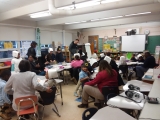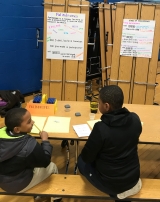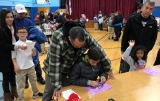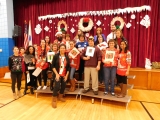-
Category 3
Selected in 2018
-
Grades: pre k - 5
School Setting: urban
Town Population: 0
Student Enrollment: 255
Student Demographics:
Black/African American: 16.1%
Teacher/Student Ratio: 1:11
White/Caucasian: 14.9%
Hispanic: 54.5%
Hawaiian/Pacific Islander: 0%
Asian: 11.8%
Native American: 0%
Other: 2.7%
% Reduced Lunch: 100%
% ELL Learners: 18.4%
Founded: 1962 -
PRINCIPAL:
Deborah Beglane -
CONTACT:
285 Tiffany Street
Springfield, MA 01108
413-787-7544
beglaned@springfieldpublicschools.com
Alice B. Beal Elementary School
Springfield, MA
Our philosophy is that we will meet students where they are, provide the support/resources/strategies needed in order for all students to make progress/growth.
- Describe specific programs in place to ensure that families are involved in the success of your school and students.
-
Grade level family functions-parents come in to work with their child around content, for example the fifth grade writing teacher had parents come in to work with their child on a writing piece so that could have a clearer understanding of the writing process and expectations.
Mulitculural school-wide event: Our students put on a multi-cultural event that represents the cultures of our students
Winter wonderland Event: Event to celebrate winter holidays.
Math Night: Fun math activities are set up so that parents work with their children to understand the concepts and to get ideas how to help their child at home
Literacy Events: Book Walks, Author Visits, Read Alouds, Writing activities, etc.
Math Challenges during vacations
Summer reading list/challenge
Summer math games sent home to families
iReady code sent home (summer)
Links to Libraries: Classrooms are matched up with a reader who comes in to read a book to the students. Each student goes home with a book after each visit.
- Describe the most successful activity your school has initiated to strengthen ties to your community.
- We have established a relationship with Reader to Reader which is associated with Amherst College. The program has our fifth grade stduents paired with a college student reading the same book and doing an online bookchat. This is monitored by Reader to Reader and our fifth grade ELA teacher. At the end of the year there is a columinating activity in which the fifth graders go to Amherst College and meet their mentor.
- Describe your philosophy of school change or improvement.
- Our philosophy is that we will meet students where they are and while maintaining our high expectations provide the support/resources/strategies needed in order for all students to make progress/growth in order to meet our state standards.
- What are your school’s top two goals for the next year?
-
Differention of instruction to continue to meet the needs of all students
How to choose the correct resources to use during instruction in order to meet the needs of students - What is the single most important factor in the success of your school that others could replicate?
- Targeting what intervention and the focus of it that students will receive and providing time whithin the schedule during the instructional blocks. This is done for all students, so that students, no mater what level they are at, make growth.
- Describe the program or initiative that has had the greatest positive effect on student achievement, including closing achievement or opportunity gaps, if applicable.
- Data to determine who received interventions, who provides interventions (all students), targeting which intervention to use and what is focused on. Provided PD on how to determine what students need adn what to focus on added math interventions
- Explain how ESEA federal funds are used to support your improvement efforts.
-
We were able to get a full math coach, 2 full time tutors who focus on basic skills in lower grades, and an interventionist, purchased leveled texts to use during guided reading, purchased math manipulatives to use during math instruciton
- Identify the critical professional development activities you use to improve teaching and student learning.
-
Using data to target instruction to meet students needs
Reinforcing foundation skills of teaching reading, writing, and math
Focus on vocabulary instruction (strategies to use during instruction) and ways to reinforce it across all content areas
Unpacking the state standards
How to use materials available to meet the needs of students
- Describe how data is used to improve student achievement and inform decision making.
-
We look at our data to determine historical school trends and trends by grades and individual teachers. PD is planned and presented for historical trends. During PLC time grade level trends are addressed and coaching sessions for individual teacher's trends. Our teachers use their data to plan reteaching lessons.
We use our data for our interventions. We determine which students will receive services and which intervention to use. We also look at our Special Education and E.S.O.L. students' data to determine the areas of focus and goals for IEP's. We have also made adjustments to our E.S.O.L. schedule, while maintaining state and federal requirements, in order to best meet the needs of the students. We have used special edcuation student's data to determine minutes of instruction in reading, writing, and math while maintaining state and federal requirements.
- Describe your school culture and explain changes you’ve taken to improve it.
- It is a culture in which staff, teachers, and students collaborate and help each other. We have added students from upper grades informally helping out students in lower grades. Fifth grade students helping first grade students with sight words and Student Academic Mentors helped kindergartens with letter sounds and sight words. The Parent Facilitator helps parents become aclamated to our school and teachers here support teachers new to a grade or the school. PLC's were created as a method for teachers to collaborate around content, lessons, and data.
Stats
-
Category 3
Selected in 2018
-
Grades: pre k - 5
School Setting: urban
Town Population: 0
Student Enrollment: 255
Student Demographics:
Black/African American: 16.1%
Teacher/Student Ratio: 1:11
White/Caucasian: 14.9%
Hispanic: 54.5%
Hawaiian/Pacific Islander: 0%
Asian: 11.8%
Native American: 0%
Other: 2.7%
% Reduced Lunch: 100%
% ELL Learners: 18.4%
Founded: 1962 -
PRINCIPAL:
Deborah Beglane -
CONTACT:
285 Tiffany Street
Springfield, MA 01108
413-787-7544
beglaned@springfieldpublicschools.com








